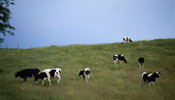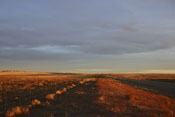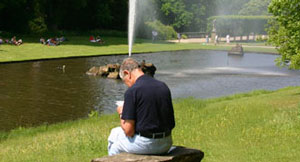Almost everyone has a camera. When cellphones are included, most families have three or four. And people are constantly snapping photographs: at home, out a car window, even while standing in line at a restaurant.
Cameras have become so common and easy to use that almost no one thinks before they click. And most believe that classy, artistic photographs can be captured only by professionals with pricey equipment.
This is not true!
Recall the old saying, “A picture is worth 1,000 words.” There is a lot you can convey in a photograph that can be difficult to describe verbally. If you follow a few simple rules, you can begin learning to produce great photos. These will be pictures you gladly show to others, pictures with value—pictures worth 1,000 words!
To take an effective picture, you must first compose it. Composing a photograph can be summarized by this principle: pay attention to everything that is in the frame.
This cardinal rule can be split into many rules of composition, which address what objects you remove from a photo and where you place each item that you leave in. Here are a few:

Source: Thinkstock

Source: Thinkstock

Source: Thinkstock
• Fill the viewfinder: If you are taking a picture of your new puppy, Spot, he should usually fill most of the image. Often, a person will snap a photo only to realize later that it is 95 percent grass around the puppy and only 5 percent of Spot. If you are closer, you can see the wrinkles in the puppy’s face and can more easily tell his mood, whether playful, sleepy or scared. (See the top picture to the right.)
• Rule of thirds: If you cut an image into a grid of thirds, your main focal points should generally be placed where the lines intersect (notice the sailboat to the right). This adds visual interest to the photo.
• Coverage: One secret of professional photographers is that they take TONS of photos! Many of the pros will tell you that they expect to get just one acceptable photo per 30 exposures, and that it takes many more to get an exceptional one. When you want to photograph something, be sure to take it from different angles to fully “cover” the subject. You can choose your favorite one later. The more you take, the more likely you will get excellent pictures. Experiment to learn how your camera works best. Most important, have fun!
The following images demonstrate other principles of composition.

Get close to your subject: The photo above appears flat and uninteresting. Notice that the sky and grass almost cut the image in half, breaking the rule of thirds. There is a tree just barely in the view and dairy cows scattered all over. To solve this, you could find a more interesting setting for the cattle, such as the next image. There, the cows’ eyes are all on a “thirds line,” and have filled the frame, making you able to see the animals’ features.
Source: Thinkstock

Source: Thinkstock

Wrong timing: This landscape shot is ineffective for a number of reasons: it breaks the rule of thirds, there is no object filling the viewfinder to draw your attention, and there are no shadows to provide contrast. In this case, it would have been better to find a lizard or some other animal and take a few close-up shots of it instead.
Source: Thinkstock

Worth the wait: Compared with the previous photo, this landscape shot draws your attention. The colors stand out because the sun is beginning to set. Sometimes, all that is required is for you to wait. (Note that the horizon is on a “third line.”) The fence and road also create lines of interest that end on the horizon.
Source: Thinkstock

Avoid bad mergers: Pay attention to where objects are in a photo. If you are not careful, a fountain in the background can “shoot” out of a person’s head and ruin your shot!
When two objects appear to unintentionally intersect in a photo, it is called a “bad merger.”
Always make sure that you eliminate everything that is unneeded or distracting in the frame by changing your angle or moving closer. This will simplify your composition and make your image more effective.
Source: Thinkstock

Keep it simple: Instead of showing the field these flowers are in, the purple flowers beside them, and the rustic shack next to it, the photographer here crouched low to the ground and used the blue sky to simplify this image. This composition eliminates anything that could distract you, and forces you to focus on a few flowers.
Source: Thinkstock

Squeeze in: When taking pictures of family and friends, be sure to fill the viewfinder. Doing so allows you to see them, their smiles and the joy in their eyes. Family photos are meant so that you can remember those in the picture—get close!
Source: Thinkstock

Tell a story: When taking pictures of events or activities, include enough details so the viewer knows what is occurring. Here, the picture could have probably been strengthened by rearranging some of the items and taking the picture from a higher angle.
Source: Thinkstock

Unusual occurrence: Keep your eyes open for the unexpected. Here, a snowstorm surprised a number of bicyclists, creating a photo you would not normally be able to take. Also, the contrast between shadow and light adds interest to the photograph.
Source: Thinkstock

Interesting angle: Do not keep taking the same photograph over and over. Sometimes it helps to get a fresh perspective. To really capture this shipyard, the photographer found a place where he could have a bird’s-eye view. This angle shows the scale and busyness of this area.
Source: Thinkstock

On Location: When taking a photo of a person while on vacation, you will likely not want to fill the viewfinder completely with your subject. In this case, it is good to have a landmark or location visible in the background. Yet you should still make sure the person is close to the camera so you can see his face, such as this teenager snorkeling in the Caribbean Sea.
Source: Thinkstock
The more often you compose photos, the easier it will become. You will begin to more quickly see the best way to photograph specific subjects, whether close-up, at eye-level, or far away.
Thinking like a photographer will also teach you to see things from many different perspectives. It is a wonderful creative outlet, where you can almost always try something new. You will find beauty in small details, such as the way light illuminates the fur of a cat dozing in the sun or the mirror-like qualities of dewdrops on leaves in the morning. Seeing these will help you better appreciate God’s Creation.
Best of all, once your photos are printed, you can share these moments with others!
There are many more points to consider when using a camera, such as exposure length, f-stops and depth of field. But not knowing these terms, or what they mean, should not stop you from beginning to compose great pictures or enjoy photography. If you want to learn more, there are many resources available online that teach more advanced techniques.
You now know the basics. Pick up your camera, compose your shot, and take an image worth 1,000 words!






























